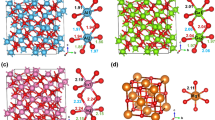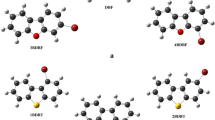Abstract
The effects of oxygen (O) termination on the electronic and structural properties of a (6,0) boron nitride nanotube (BNNT) were investigated by density functional theory (DFT) calculations. All-atomic optimization and calculations of chemical shielding (CS) properties were performed for four models of the investigated BNNT based on different termination of the nanotube by the O atoms: perfect, OB-end, ON-end, and OBN-end models. The results indicate that the B–N bond lengths are not changed by O-termination but the tubular diameters, dipole moments, and band gaps are substantially changed, especially for the OBN-end model in which both tips are terminated by the O atoms. The CS properties also indicate that the atoms of the models are divided into layers on the basis of similar electronic environment in each atomic layer. In the OB-end model where the atoms of the B-tip are substituted by the O atoms, the results are indicative of attraction between the N and O-terminating atoms but in the ON-end model where the atoms of the N-tip are substituted by the O atoms, strong bonds between the B and O-terminating atoms are detected.
Graphical abstract



Similar content being viewed by others
References
Iijima S (1991) Nature 354:56
Coleman JN, O’Brien DF, McCarthy B, Barklie RC, Blau WJ (2001) Monatsh Chem 132:53
Treboux G, Nakamura S (2009) 140:839
de Menezes VM, Fagan SB, Zanella I, Mota R (2009) Microelectron J 40:877
Ni MY, Zeng Z, Ju X (2009) Microelectron J 40:863
Chen X, Ma J, Hu Z, Wu Q, Chen Y (2005) J Am Chem Soc 127:17144
Zhang D, Zhang RQ (2003) Chem Phys Lett 371:426
Loiseau A, Willaime F, Demoncy N, Schramcheko N, Hug G, Colliex C, Pascard H (1998) Carbon 36:743
Mirzaei M (2009) Z Phys Chem 223:815
Mirzaei M (2009) Monatsh Chem 140:1275
Song J, Huang Y, Jiang H, Hwang KC, Yu MF (2006) Int J Mech Sci 48:1197
Arenal R, Ferrari AC, Reich S, Wirtz L, Mevellec Y-J, Lefrant S, Rubio A, Loiseau A (2006) Nano Lett 6:1812
Blasé X, Rubio A, Louie SG, Cohen ML (1994) Europhys Lett 28:335
Chopra NG, Luyken RJ, Cherrey K, Crespi VH, Cohen ML, Louie SG, Zettl A (1995) Science 269:966
Zhang SL (2001) Phys Lett A 285:207
Hou S, Shen Z, Zhang J, Zhao X, Xue Z (2004) Chem Phys Lett 393:179
Frisch MJ, Trucks GW, Schlegel HB, Scuseria GE, Robb MA, Cheeseman JR, Zakrzewski VG, Montgomery JA Jr, Stratmann RE, Burant JC, Dapprich S, Millam JM, Daniels AD, Kudin KN, Strain MC, Farkas O, Tomasi J, Barone V, Cossi M, Cammi R, Mennucci B, Pomelli C, Adamo C, Clifford S, Ochterski J, Petersson GA, Ayala PY, Cui Q, Morokuma K, Malick DK, Rabuck AD, Raghavachari K, Foresman JB, Cioslowski J, Ortiz JV, Baboul AG, Stefanov BB, Liu G, Liashenko A, Piskorz P, Komaromi I, Gomperts R, Martin RL, Fox DJ, Keith T, Al-Laham MA, Peng CY, Nanayakkara A, Gonzalez C, Challacombe M, Gill PMW, Johnson B, Chen W, Wong MW, Andres JL, Gonzalez C, Head-Gordon M, Replogle ES, Pople JA (1998) GAUSSIAN 98. Gaussian, Inc., Pittsburgh
Wolinski K, Hinton JF, Pulay P (1990) J Am Chem Soc 112:8251
Nouri A, Mirzaei M (2009) J Molec Struct (THEOCHEM) 913:207
Mirzaei M, Nouri A (2010) J Molec Struct (THEOCHEM) 942:83
Author information
Authors and Affiliations
Corresponding author
Rights and permissions
About this article
Cite this article
Mirzaei, M., Mirzaei, M. A computational study of oxygen-termination of a (6,0) boron nitride nanotube. Monatsh Chem 141, 491–494 (2010). https://doi.org/10.1007/s00706-010-0287-3
Received:
Accepted:
Published:
Issue Date:
DOI: https://doi.org/10.1007/s00706-010-0287-3




